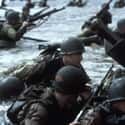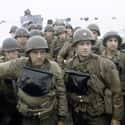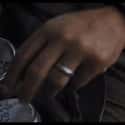-
(#7) Soldiers Did Get Seasick Crossing The English Channel
For director Steven Spielberg, it was important to capture the complexities of the conditions on D-Day:
It was a blustery day at 6:30 a.m. in the Dog Green sector of Omaha Beach, and the English Channel was a maelstrom. It was all waves and seasickness and waiting for the landing to begin. I wanted this shot to simply symbolize the calmest moment you’d get in the entire experience of watching this film.
The fear seen in the faces of the soldiers as they are transported to the beaches of Normandy in Saving Private Ryan emphasizes the emotions felt by those men as they went into combat. Additionally, bouts of seasickness brought to life the physical reactions to both the choppy waters of the English Channel and the palpable terror in the moments before battle.
The honest portrayal of seasickness resonated with veterans like Ted Cordery and Harold Baumgarten. Cordery recalled seeing how "bouncing" boats caused seasickness among troops as they approached the beaches of Northern France. For his part, Baumgarten staved off getting sick during his transport across the English Channel by skipping breakfast on the morning of the invasion.
-
(#6) Soldiers Did Throw Mortar Shells During WWII
In one scene in Saving Private Ryan, Matt Damon throws a mortar shell, an action that actually led to many individuals who watched the movie crying foul. According to naysayers, no soldier would have ever thrown such a dangerous piece of ammunition.
There are accounts of soldiers doing just that, however. Technical Sergeant Beauford T. Anderson received a Congressional Medal of Honor for his service during WWII, with a citation that read in part:
He seized an enemy mortar dud and threw it back among the charging [Japanese], killing several as it burst. Securing a box of mortar shells, he extracted the safety pins, banged the bases upon a rock to arm them and proceeded alternately to hurl shells and fire his piece among the fanatical foe, finally forcing them to withdraw.
Chuck "Commando" E. Kelly also earned a Congressional Medal of Honor, having "picked up 60-mm mortar shells, pulled the safety pins, and used the shells as grenades, killing at least five of the enemy" while serving in Italy in 1943.
-
(#1) Heavy Equipment Made It Incredibly Hard For The Landing Forces To Get Solid Footing
The struggle to get to shore on D-Day was multifaceted. Heavy gear, equipment, and supplies weighed soldiers down, while constant artillery fire threatened every move. As 20-year-old Ted Cordery watched on, he saw several soldiers never even get to the beaches of Normandy, succumbing to the English Channel instead.
Saving Private Ryan accurately shows troops let off into water that was too deep for them to touch the ground. Cordery recalled decades later:
I felt so sorry for the men. They were coming from a fair way out to get to the beach, and they were all in their uniforms and carrying guns and their own food, so they all had these cans weighing them down... So many of them didn't make it because they were dropped too far from the land. They went straight in the deep water and drowned.
-
(#5) The Soldiers In The Movie Wore Unfastened Helmets
Throughout Saving Private Ryan, soldiers are shown wearing helmets with chinstraps either hanging by the sides of their heads or fastened in the back. During WWII, it was common for men to leave their M1 helmets - made of an outer steel shell and an inner liner - unfastened due to concern among soldiers that a chinstrap would be dangerous in an explosion. The fear was that the force from the blast would blow one's helmet back, breaking the wearer's neck in the process.
It was reported that General George S. Patton even ordered men to leave their helmets unfastened after one of his aides perished in Tunisia in this exact manner.
-
(#12) Soldiers Often Collected Dirt As A Symbol Of Where They'd Served
Tom Sizemore's character, Sergeant Horvath, is seen gathering soil from France and placing it in a tin. When he puts the small container in his bag, there's a glimpse of similar tins labeled Italy and Africa, indicating he's collected dirt and sand from those locations, as well.
What Horvath does in Saving Private Ryan was common for WWII soldiers. Many men who served took home souvenirs. Talismans like soil, seashells, and rocks taken from the places they served functioned as a special reminder of survival. Such items could also become a source of good luck.
When Frank Gagliano, a member of the 101st Airborne who stormed Omaha Beach on D-Day, revisited Normandy decades after the invasion, he actually grabbed some sand to take home with him. Gagliano noted, "I didn't think to do it the first time... I was too busy trying to stay alive."
-
(#4) Director Spielberg Insisted On Casting Real-Life Amputees - With One Clear Exception
Instead of filming the movie and later removing limbs or adding other injuries via computer effects, Steven Spielberg opted to incorporate real-life amputees into his cast.
According to associate producer Mark Huffam:
We had somewhere between 20 and 30 amputees and paraplegics who worked with us, creating very realistic scenes where we could use effects to make it look like soldiers were losing limbs. Some might say it was an insensitive approach, but they all did it with great enthusiasm.
Not only did this add to the film's realism, but it also mitigated post-production costs.
One actor who appeared as an amputee - but notably wasn't - however, was Bryan Cranston.
New Random Displays Display All By Ranking
About This Tool
Our data comes from Ranker, If you want to participate in the ranking of items displayed on this page, please click here.






